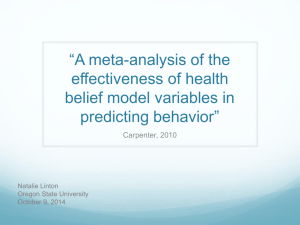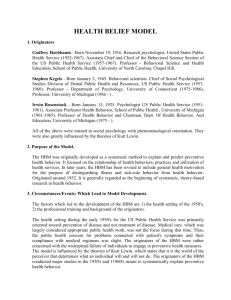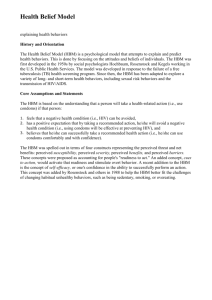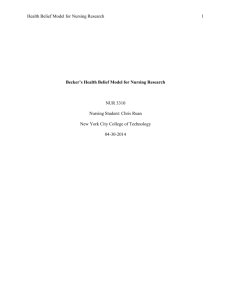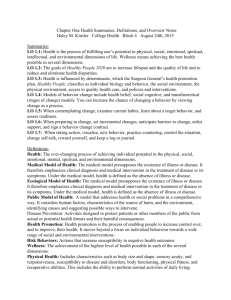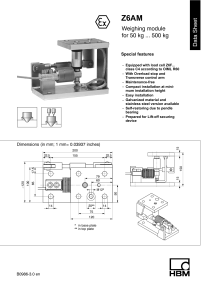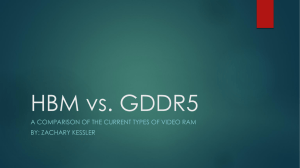Health Belief Model (HBM)
advertisement
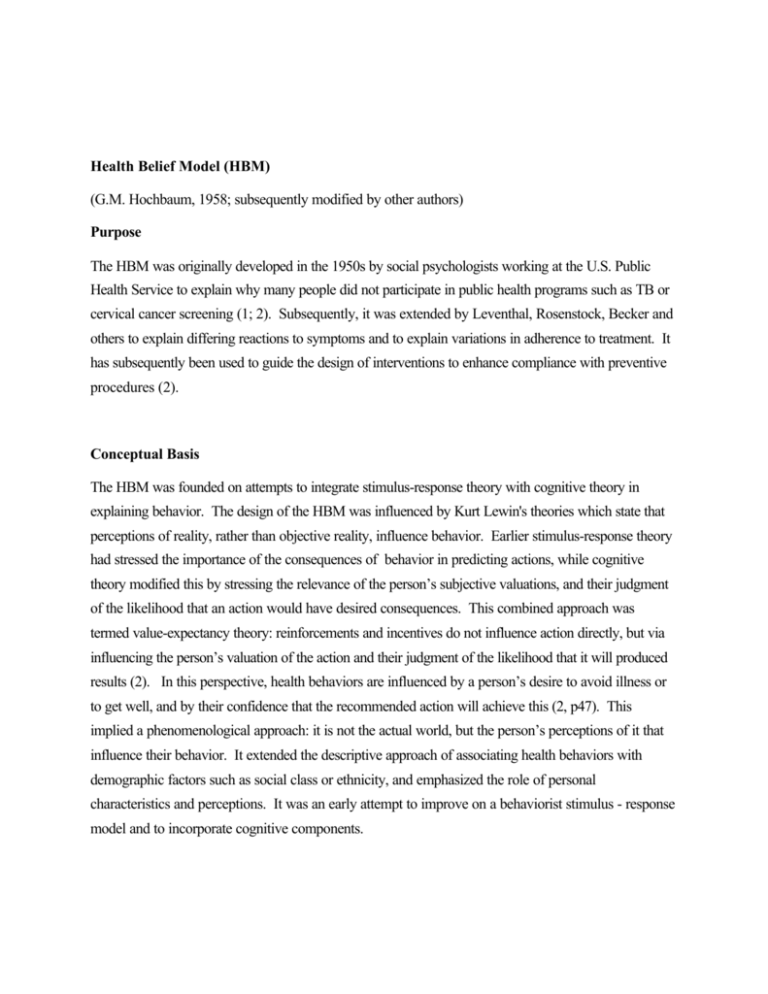
Health Belief Model (HBM) (G.M. Hochbaum, 1958; subsequently modified by other authors) Purpose The HBM was originally developed in the 1950s by social psychologists working at the U.S. Public Health Service to explain why many people did not participate in public health programs such as TB or cervical cancer screening (1; 2). Subsequently, it was extended by Leventhal, Rosenstock, Becker and others to explain differing reactions to symptoms and to explain variations in adherence to treatment. It has subsequently been used to guide the design of interventions to enhance compliance with preventive procedures (2). Conceptual Basis The HBM was founded on attempts to integrate stimulus-response theory with cognitive theory in explaining behavior. The design of the HBM was influenced by Kurt Lewin's theories which state that perceptions of reality, rather than objective reality, influence behavior. Earlier stimulus-response theory had stressed the importance of the consequences of behavior in predicting actions, while cognitive theory modified this by stressing the relevance of the person’s subjective valuations, and their judgment of the likelihood that an action would have desired consequences. This combined approach was termed value-expectancy theory: reinforcements and incentives do not influence action directly, but via influencing the person’s valuation of the action and their judgment of the likelihood that it will produced results (2). In this perspective, health behaviors are influenced by a person’s desire to avoid illness or to get well, and by their confidence that the recommended action will achieve this (2, p47). This implied a phenomenological approach: it is not the actual world, but the person’s perceptions of it that influence their behavior. It extended the descriptive approach of associating health behaviors with demographic factors such as social class or ethnicity, and emphasized the role of personal characteristics and perceptions. It was an early attempt to improve on a behaviorist stimulus - response model and to incorporate cognitive components. Description The HBM breaks down health decisions into a series of stages and offers a catalogue of variables that influence health action; it does not provide a model of exactly how these operate. In the HBM, the likelihood that a person will follow a preventive behavior is influenced by their subjective weighing of the costs and benefits of the action; the perception involves the following elements: Perceived susceptibility: the person’s judgment of his or her risk of contracting the condition. This might be measured by questions such as “Taking all factors into account, what do you think are your chances of getting [the disease]?” Perceived seriousness of the condition: the severity of the of the condition (its clinical consequences, disability, pain or death) and its impact on life style (working ability, social relationships, etc.). Questions might include “If you got [the disease], how serious would that be?” Or, more objective indicators might be used, such as the number of days off work or in bed. The combination of perceived susceptibility and seriousness is termed perceived threat (see Figure 1). The perceived threat has a cognitive component and is influenced by information. It creates a pressure to act, but does not determine how the person will act. That is influenced by the balance between the perceived efficacy and cost of alternative courses of action: Perceived benefits of an action: will the proposed action be effective in reducing the health risk? Does this course of action have other benefits? Again, it is the person’s beliefs, rather than factual evidence, that is influential. The beliefs will reflect social and cultural influences. Assessments might include “Do you think there is anything that could be done to prevent this condition? How effective would that be?” Perceived barriers to action: How do these benefits compare to the perceived costs of action? Are there barriers to action? Will it involve expense, pain, or embarrassment? This can be assessed via questions such as “What difficulties do you see in undertaking this action?” An 11-item barrier scale for adopting preventive behaviors for AIDS was published by Maguen et al. (3). Note that there may be difficulties in scoring such responses, and the barriers mentioned may be quite independent of each other. The balance between benefits and costs may suggest the person’s likelihood of acting and their preferred course of action, but do not necessarily determine that they will act. Indeed, if benefits are closely balanced against costs the person may vacillate, perhaps experiencing anxiety. The final ingredient in the HBM was therefore: A stimulus or cue to action. When a person is motivated and can perceive a beneficial action to take, actual change often occurs when some external or internal cue (e.g., a change in health, the physician’s advice, or a friend’s death) triggers action. As cues may be fleeting events they are elusive to record (2, p50). The magnitude of the cue required to trigger action would depend on the motivation to change and the perceived benefit to cost ratio for the action (1). Although Hochbaum saw cues as being crucial, they have rarely been studied empirically. Modifying Factors · Demographics (age, sex, ethnicity, etc.) · Sociopsychological variables (personality, social class, peer and reference group pressures, etc.) · Structural variables (knowledge about the disease, prior experience of it, etc.) Perceived Susceptibility to Disease Perceived Severity of Disease Perceived Threat of the Disease Perceived benefits of taking action, minus Perceived barriers to action Cues to Action · Raised awareness (e.g., mass media campaign, newspaper article ) · Personal advice (e.g., reminder from health professional) · Personal symptoms · Illness of family member or friend Likelihood of Taking Recommended Health Action Figure 1. The variables in the Health Belief Model. Adapted from Rosenstock, Janz and others (1; 2) It is clear that the HBM focuses on avoiding disease rather than on achieving health. Rosenstock noted that this was in part due to the difficulty in framing questions in terms of positive health. Validity Few of the studies that have evaluated the HBM provide results that can be summarized numerically. As early as 1974, Rosenstock reviewed seven studies that had evaluated the HBM (4). Six lent “support to the importance of several of the variables in the model as explanatory or predictive variables. However, a seventh major investigation conflicted in most respects with the findings of earlier studies.” (4, p364). Rosenstock noted that the first six studies were undertaken following widespread public advertising alerting the public to particular health issues; the seventh study was undertaken in the absence of any campaign. Rosenstock concluded that the HBM can predict voluntary health behavior in people who are essentially healthy. Janz and Becker’s review showed that prospective studies supported the predictive validity of the HBM, as did several cross-sectional studies (5). Perceived barriers appear as the single best predictor of subsequent behavior. Janz et al. reported on a series of studies that evaluated the HBM in predicting uptake of mammography screening, and also reviewed several studies that used it in designing interventions to increase screening (2, p54). They concluded that interventions that incorporated the HBM precepts tended to produce superior results, but it is often not possible from the studies to isolate the effects of the HBM from other characteristics of the intervention. Rosenstock also noted that positive health beliefs as described in the HBM are more likely to occur among middle class people who have a future orientation, who make deliberate plans and favor longterm goals over immediate gratification. Alternative Forms Reactions to the HBM suggested that it held merit, but explained rather little variance. Accordingly, many derivatives have been proposed. Examples include Langlie’s model that included perceived vulnerability, perceived benefits of changing health behavior, barriers & costs, health locus of control, socioeconomic status, and situational constraints. Antonovsky and Kats proposed a model of preventive health behavior that built on the HBM and included three classes of variables (6). ‘Predisposing motivation’ was influenced by the desire to avoid illness, to gain approved by others and to pursue personal values. ‘Blockage variables’ included a lack of knowledge and resources. ‘Conditioning variables’ included factors that modify the above variables, such as perceived susceptibility, SES, and previous illness experience. In this theory, cognitive factors operate chiefly by modifying motivation. This approach differed from the HBM in that it explicitly included motivation and also replaced the linear associations between the factors and health behaviors by a threshold model. David Mechanic proposed ten types of influence on behavior, most referring to the first stages of the HBM: frequency and visibility of symptoms; their seriousness; the person’s tolerance threshold; their level of knowledge; the availability of treatment and constraints on action (such as job demands). Cummings et al. reviewed 14 models of health behaviors and asked eight experts judge the similarity of the variables they contained. From this, a form of multidimensional scaling produced six categories of variables: Accessibility of health services; Attitudes towards health care; Threat of illness; Knowledge about disease; Social network factors (e.g. social pressures, support, traditions); Demographic factors (SES, etc) (7). Commentary The HBM is generally taken as marking the beginning of systematic and theory-based research on health behavior. It has been widely used and applied to explaining health behaviors as well as used to design intervention programs. It has been used in cross-cultural studies, although its constructs may need to be adapted to each cultural group. Tang et al., for example, studied cultural barriers in participation in cancer screening among Chinese and Asian peoples in the U.S. (see (2, p59). The perceived benefits of the HBM resemble Bandura’s concept of outcome expectations (2). Following Bandura’s development of social learning theory, Rosenstock et al. suggested that self efficacy be added to the HBM, to cover the person’s sense of confidence that they could successfully change behavior to produce the desired outcomes. As Janz et al. note, however, this represents an extension of the original purpose of the HBM, for it originally applied to single actions such as receiving an immunization, while self efficacy is most relevant to health actions that require sustained effort, such as smoking cessation (2, pp50-51). The HBM does not cover habitual behaviors or those constrained by custom and tradition. Cognitive models focus on voluntary health behaviors, but when behaviors are legislated or required (as with health checks as a condition of employment) they will not apply. Social pressure may also modify behaviors, and this lies beyond the scope of most models of health behavior. Among limitations of the HBM, Janz et al. noted that the concepts have been inconsistently and often poorly measured (2, p52), making it difficult to draw comparisons across studies. But this criticism may be misplaced, because measures of concepts such as barriers to action cannot be measured generally, but have to be specific to particular behaviors. The HBM describes constructs that predict behaviors, but it says nothing of how these are expected to interrelate. Do they follow an additive or a multiplicative model? What time frame is anticipated across the various components of the model? Janz et al. suggested several testable hypotheses that could guide further testing of the structural characteristics of the HBM (2, pp60-61). References (1) Rosenstock IM. Historical origins of the Health Belief Model. Health Educ Monogr 1974; 2:328-335. (2) Janz NK, Champion VL, Strecher VJ. The Health Belief Model. In: Glanz K, Rimer BK, Lewis FM, editors. Health behavior and health education: theory, research, and practice. San Francisco: Jossey-Bass, 2002: 45-66. (3) Maguen S, Armistead LP, Kalichman S. Predictors of HIV antibody testing among gay, lesbian, and bisexual youth. J Adolesc Health 2000; 26:252-257. (4) Rosenstock IM. The Health Belief Model and preventive health behavior. Health Educ Monogr 1974; 2:354-386. (5) Janz NK, Becker MH. The Health Belief Model a decade later. Health Educ Q 1984; 11:147. (6) Antonovsky A, Kats R. The model dental patient: an empirical study of preventive health behavior. Soc Sci Med 1970; 4:367-380. (7) Cummings KM, Becker MH, Maile MC. Bringing the models together: an empirical approach to combining the variables used to explain health actions. J Behav Med 1980; 3:123-145.
